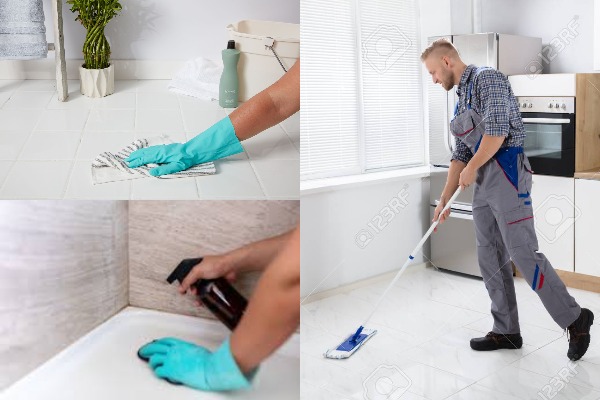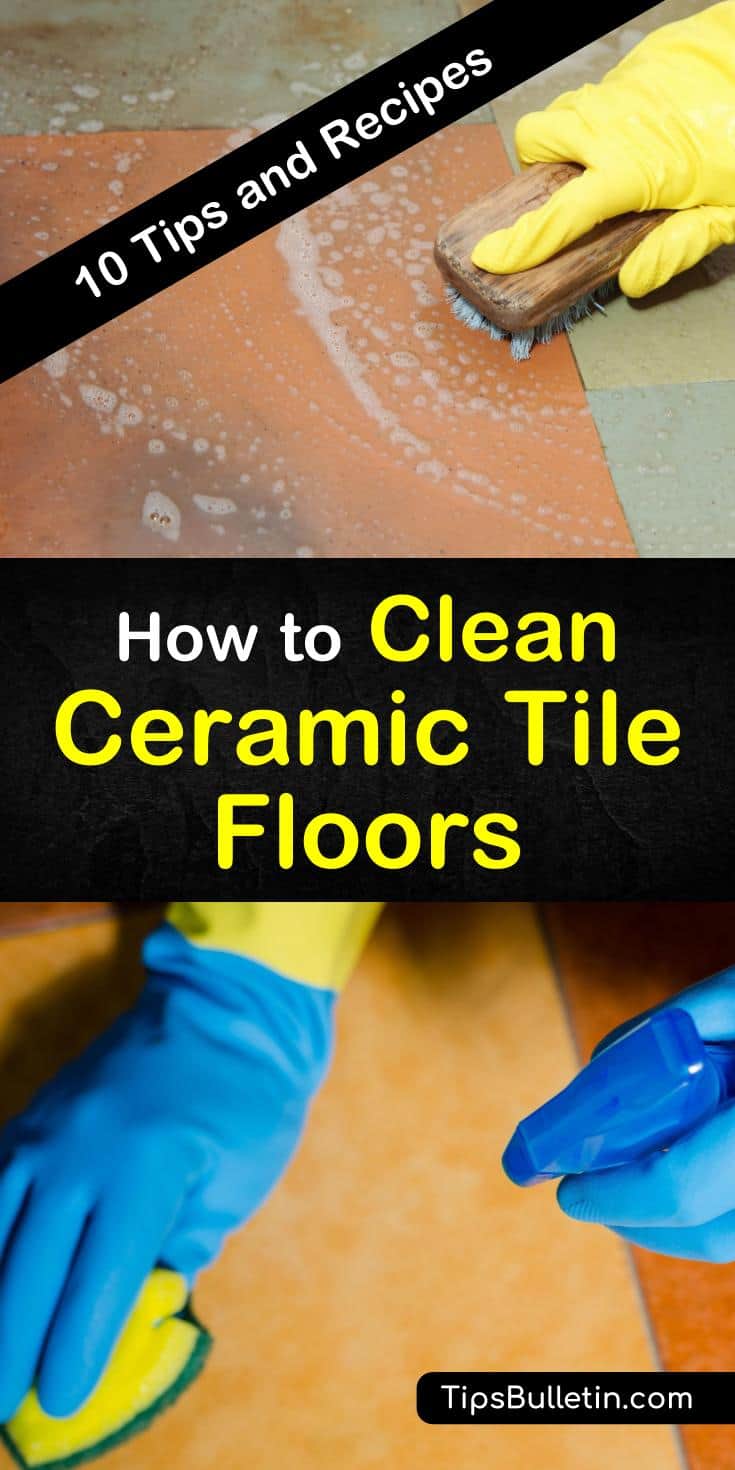Ceramic tile floors are a popular choice for many homeowners due to their durability, versatility, and aesthetic appeal. However, keeping them clean and looking their best can be a bit of a challenge if you don’t know the right techniques. In this guide, I’ll share the best ways to clean ceramic tile floors, common mistakes to avoid, and answer some frequently asked questions to help you maintain your floors in pristine condition.
Preparing Your Floors for Cleaning
Clearing the Area
Before you begin cleaning, it’s essential to clear the area of any furniture, rugs, or other items that could get in the way. This allows you to clean the entire floor surface without any obstructions and ensures you don’t miss any spots. I always make sure to move everything out of the way to make the cleaning process more efficient.
Sweeping or Vacuuming
The next step is to remove loose dirt and debris from the floor. Sweeping with a soft-bristled broom or using a vacuum cleaner with a hard floor setting is the best way to do this. Pay extra attention to corners and edges where dirt tends to accumulate. I’ve found that a thorough sweep or vacuum makes the subsequent cleaning steps much easier and more effective.
Spot Cleaning
Before you mop the entire floor, it’s a good idea to clean any stains or sticky spots. Use a damp cloth or sponge with a mild cleaning solution to tackle these areas. This helps prevent the spread of stains during mopping. I’ve noticed that dealing with spots beforehand ensures a more even clean.
Choosing the Right Cleaner
Selecting the right cleaning solution is crucial for maintaining the integrity and appearance of your ceramic tiles. Avoid harsh chemicals and opt for a pH-neutral cleaner specifically designed for ceramic tiles. Personally, I prefer using natural or homemade cleaners to avoid any potential damage from strong chemicals.
Preparing Your Mop
For mopping, a microfiber mop or a traditional string mop works well. Make sure the mop head is clean and free of any dirt or debris. Soak the mop in your chosen cleaning solution and wring out any excess liquid. A damp mop is more effective than a soaking wet one, as too much water can seep into the grout and cause damage over time.
Testing Your Cleaner
Before applying the cleaning solution to the entire floor, test it on a small, inconspicuous area to ensure it doesn’t cause any discoloration or damage. This step is especially important if you’re using a new or homemade cleaner. I’ve learned that this precautionary measure can save you from potential headaches down the line.

Mopping Techniques for Sparkling Floors
Mopping in Sections
To ensure a thorough clean, mop the floor in sections. Start at one corner of the room and work your way across, rinsing the mop frequently to avoid spreading dirt. This method ensures that each area gets the attention it needs. I’ve found that dividing the floor into manageable sections makes the task less overwhelming and more efficient.
Using the Right Amount of Solution
Using too much cleaning solution can leave a sticky residue on your tiles, while too little may not effectively clean the surface. Follow the manufacturer’s instructions for the correct dilution ratio. I always measure the solution carefully to avoid any buildup and ensure a streak-free finish.
Avoiding Excess Water
Excess water can penetrate the grout lines and weaken them over time. Wring out your mop thoroughly before applying it to the floor. This is especially important for ceramic tiles, as they are less porous but still susceptible to water damage. In my experience, a damp mop is just as effective as a wet one, without the risk of damaging the grout.
Rinsing the Mop Frequently
Rinse your mop in clean water frequently to remove dirt and prevent it from being redeposited on the floor. This is a crucial step for maintaining a clean and shiny surface. I’ve noticed that regular rinsing keeps the mop effective and the floors cleaner.
Changing the Water
Change your mop water when it becomes cloudy or dirty. Using dirty water to clean will only spread dirt around and make the floor look worse. I always keep an eye on the water and switch it out as needed to ensure I’m cleaning with fresh water.
Final Rinse
After mopping with the cleaning solution, it’s a good idea to do a final rinse with clean water to remove any leftover cleaner residue. This step helps maintain the shine and prevents any dulling of the tiles. I’ve found that this extra rinse leaves the floors looking their absolute best.
Common Mistakes to Avoid
Using Harsh Cleaners
One of the most common mistakes is using harsh or abrasive cleaners on ceramic tiles. These can damage the surface and grout, leading to dullness and deterioration. I always opt for gentle, pH-neutral cleaners to avoid this issue.
Skipping Regular Cleaning
Neglecting regular cleaning can lead to a buildup of dirt and grime, making it harder to clean the floors later. Consistent maintenance is key to keeping your ceramic tiles looking new. I’ve found that a regular cleaning schedule keeps my floors in top condition.
Ignoring Grout Lines
Grout lines are often overlooked, but they can harbor dirt and stains. Make sure to clean the grout regularly to maintain a uniform appearance. I use a small brush and a mild cleaner to tackle the grout lines and keep them looking fresh.
Over-Wetting the Floor
Using too much water during mopping can seep into the grout and cause damage over time. Always wring out your mop well and avoid excessive water. I’ve learned that a damp mop is sufficient for cleaning without the risk of water damage.
Using the Wrong Tools
Using the wrong tools, such as stiff-bristled brushes or abrasive pads, can scratch and damage the tiles. Always use soft-bristled brooms and microfiber mops for the best results. I’ve switched to gentler tools and noticed a significant improvement in the condition of my floors.
Neglecting Spot Cleaning
Ignoring spills and stains can lead to permanent discoloration. Always address spills immediately to prevent them from setting in. I’ve made it a habit to clean up spills right away, and it has saved me from many potential stains.
Tips for Maintaining Your Ceramic Tile Floors
Regular Sweeping and Vacuuming
Regularly sweeping or vacuuming your floors prevents dirt and debris from scratching the surface and dulling the finish. Aim to do this at least a few times a week. I’ve found that staying on top of this simple task keeps my floors looking pristine.
Using Doormats
Place doormats at entryways to reduce the amount of dirt and grit tracked onto your ceramic tiles. This simple step can make a big difference in maintaining the cleanliness of your floors. I’ve noticed less dirt on my floors since adding doormats at every entrance.
Protecting High-Traffic Areas
High-traffic areas are more prone to wear and tear. Use rugs or runners in these areas to protect your ceramic tiles from excessive damage. I’ve strategically placed rugs in busy spots to preserve the condition of my floors.
Addressing Spills Immediately
As mentioned earlier, addressing spills immediately prevents stains and keeps your floors looking clean. Keep a cloth or sponge handy for quick cleanups. This habit has saved me from countless potential stains over the years.
Regular Sealing
While ceramic tiles themselves don’t require sealing, the grout lines do. Regularly sealing the grout helps to protect it from stains and moisture. I make sure to seal the grout every few months to keep it in good condition.
Professional Cleaning
Consider having your ceramic tile floors professionally cleaned once a year. Professional cleaners have the tools and expertise to deep clean and restore the tiles. I’ve found that a professional cleaning can rejuvenate my floors and keep them looking like new.
How often should I clean my ceramic tile floors?
Regular maintenance is key to keeping ceramic tile floors looking their best. I recommend sweeping or vacuuming at least a few times a week and mopping with a mild cleaner once a week. Spot cleaning spills and stains as they occur is also crucial to prevent permanent damage.
Can I use vinegar to clean ceramic tile floors?
While vinegar is a natural cleaner, its acidity can damage the finish on ceramic tiles and the grout. I advise against using vinegar and instead recommend a pH-neutral cleaner specifically designed for ceramic tiles. These cleaners are effective without the risk of damage.
What should I do if my grout is discolored?
If your grout has become discolored, a mixture of baking soda and water can help to brighten it. Apply the paste to the grout lines, let it sit for a few minutes, then scrub with a small brush. Rinse thoroughly with clean water. For stubborn stains, you may need to use a commercial grout cleaner or seek professional cleaning services.
How can I prevent my ceramic tile floors from becoming slippery?
To prevent your ceramic tile floors from becoming slippery, avoid using too much water during cleaning and ensure the floor is thoroughly dried after mopping. Placing rugs in high-traffic areas and using a cleaner specifically designed to reduce slipperiness can also help. I’ve found that keeping the floors dry is the most effective way to prevent slipping.
Is it safe to use steam cleaners on ceramic tile floors?
Steam cleaners can be used on ceramic tile floors, but it’s essential to use them correctly to avoid damaging the tiles or grout. Always check the manufacturer’s instructions and avoid using excessive steam or heat. In my experience, steam cleaning can be effective, but I prefer traditional mopping for routine maintenance.
How do I restore the shine to my ceramic tile floors?
To restore the shine to your ceramic tile floors, you can use a commercial tile polish or a mixture of water and a few drops of dish soap. Mop the floor with the solution, then buff with a clean, dry cloth. Regular polishing helps to maintain the shine and keeps your floors looking their best.
Common Mistakes to Avoid
Using Harsh Cleaners
One of the most common mistakes is using harsh or abrasive cleaners on ceramic tiles. These can damage the surface and grout, leading to dullness and deterioration. I always opt for gentle, pH-neutral cleaners to avoid this issue.
Skipping Regular Cleaning
Neglecting regular cleaning can lead to a buildup of dirt and grime, making it harder to clean the floors later. Consistent maintenance is key to keeping your ceramic tiles looking new. I’ve found that a regular cleaning schedule keeps my floors in top condition.
Ignoring Grout Lines
Grout lines are often overlooked, but they can harbor dirt and stains. Make sure to clean the grout regularly to maintain a uniform appearance. I use a small brush and a mild cleaner to tackle the grout lines and keep them looking fresh.
Over-Wetting the Floor
Using too much water during mopping can seep into the grout and cause damage over time. Always wring out your mop well and avoid excessive water. I’ve learned that a damp mop is sufficient for cleaning without the risk of water damage.
Using the Wrong Tools
Using the wrong tools, such as stiff-bristled brushes or abrasive pads, can scratch and damage the tiles. Always use soft-bristled brooms and microfiber mops for the best results. I’ve switched to gentler tools and noticed a significant improvement in the condition of my floors.
Neglecting Spot Cleaning
Ignoring spills and stains can lead to permanent discoloration. Always address spills immediately to prevent them from setting in. I’ve made it a habit to clean up spills right away, and it has saved me from many potential stains.
Related Posts:








